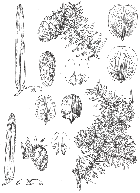Tsuga dumosa growing on Erlang Shan near Luding, Sichuan [Daniel Winkler].

Line drawing; for full size image go to the Flora of China (Wu and Raven 1999).
Tsuga dumosa growing on Erlang Shan near Luding, Sichuan [Daniel Winkler].

Line drawing; for full size image go to the Flora of China (Wu and Raven 1999).
Tsuga dumosa
Himalayan hemlock, Yunnan tieshan (Farjon 1990), Thiêt sam (FIPI 1996).
Synonymy:
See also the discussion of molecular findings on the Tsuga page.
Tree 20-25(-40) m high and 40-50(-100) cm dbh. Bark greyish brown, fissured. Branches oblique or horizontal; crown pyramidal. First year twigs are reddish brown or greyish yellow, covered with short hairs, 2-3 years old branches greyish brown or dark grey with leaf scars. Leaves spirally arranged on branches, linear, 10-25 mm long and 2-2.5 mm wide, obtuse or rounded, rarely emarginate, upper surface green and shiny, lower surface with 2 wide bands of stomata; upper half part with small dents (rarely entire). Midrib concave on upper surface. Male cones globose, solitary and axillary, green-yellow anthers without air sac. Female cones round-ovate, solitary and terminal, slightly down curved, with many spiral scales and 2 ovules inside each scale. Seeds with thin wing in upper parts, 9 mm long, ovate, brown. Flowering in April-May, fruiting in October-November. Wood brownish yellow, structure fine and veins straight (FIPI 1996). See also Wu and Raven (1999).
Himalaya: India from Uttar Pradesh to the Assam Himal (Arunachal Pradesh); N Burma; Vietnam; SE Tibet; China: NW Yunnan and into SW Sichuan (Farjon 1990). In Vietnam it is only found on Hoang Lien Son mountain, at altitudes above 1500 m. It occurs in areas with a cold climate with high rainfall, clouds and high humidity. In Vietnam, it is usually mixed with Rhododendron spp. and Abies pindrow, but sometimes forms a pure stand (FIPI 1996). Hardy to Zone 8 (cold hardiness limit between -12.1°C and -6.7°C) (Bannister and Neuner 2001).
A photograph of a specimen 320 cm dbh growing in Yunnan near Tibet appears in Pakenham (1997). Hooker (1834) reports a height of "above 120 feet" (36.6 m) for trees growing east of Lachung, Sikkim.
The oldest known living specimen, 1007 years, was documented in a tree-ring chronology covering the period 933-1996 (fully crossdated), collected near Lukuchi Khola, Nepal by Paul Krusic, Ed Cook, and Brendan Buckley (doi.org/10.25921/thdb-7m76).
Used for construction and furniture. Bark rich in tannin, that can be used for dyeing (FIPI 1996).
It has been used for dendrochronology in one exploratory study (Bhattacharyya et al. 1992).
No data as of 2023.11.06.
The epithet dumosa is a Japanese common name for hemlock, but not referring to this species.
Bhattacharyya, Amalava, Valmore C. LaMarche Jr., and Malcolm K. Hughes. 1992. Tree-ring chronologies from Nepal. Tree-Ring Bulletin 52: 59-66.
Eichler 1887. P. 80 in A. Engler and K. Prantl, Die natürlichen Pflanzenfamilien. 2(1). Available: Real Jardin Botanico, accessed 2022.12.24.
Farjon, Aljos. 1990. Pinaceae: drawings and descriptions of the genera Abies, Cedrus, Pseudolarix, Keteleeria, Nothotsuga, Tsuga, Cathaya, Pseudotsuga, Larix and Picea. Königstein: Koeltz Scientific Books.
Hooker, Joseph Dalton. 1854. Himalayan journals. London: J. Murray. 2 vols (V. 2, p. 108). Available: Biodiversity Heritage Library, accessed 2019.03.09.
Pakenham, T. 1997. Meetings with remarkable trees. Random House. Page 9.
Elwes and Henry 1906-1913 at the Biodiversity Heritage Library (as T. brunoniana) (Photo). This series of volumes, privately printed, provides some of the most engaging descriptions of conifers ever published. Although they only treat species cultivated in the U.K. and Ireland, and the taxonomy is a bit dated, still these accounts are thorough, treating such topics as species description, range, varieties, exceptionally old or tall specimens, remarkable trees, and cultivation. Despite being over a century old, they are generally accurate, and are illustrated with some remarkable photographs and lithographs.
Last Modified 2023-11-06